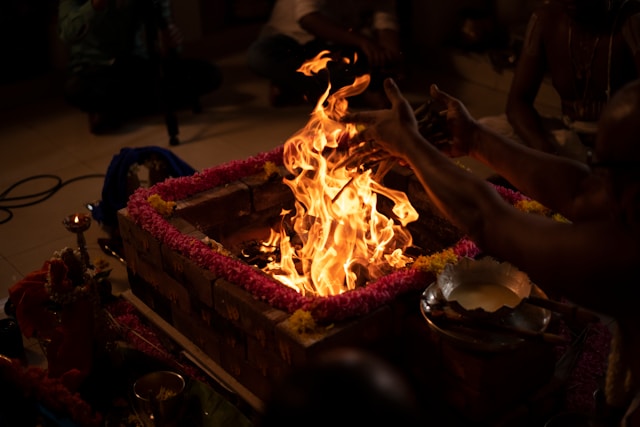Table of Contents
Since antiquity, the Vedic civilisation has been held up as a culture in tune with nature, cosmic cycles and the idea of living as one with the elements. Among its many traditions, the fire rituals—known variously as yajnas or homas—occupy a special place. These ceremonies were never just about priestly chants and ritual offerings; they were woven into the fabric of community life, festivals, and the quest for cosmic balance.
For generations, the common understanding has been that such rituals were spiritual acts – offerings meant to please the gods and invoke blessings. Yet, in recent years, a fresh question has begun to surface in both academic corridors and scientific circles: could these fire rituals have served another purpose, something far more material? Were they, in effect, an early attempt at purifying the air we breathe?
It is a question that nudges us to look again at old texts, to listen more closely to the hum of mantras, and to pay attention to what actually happens when clarified butter, herbs, and grains meet the flames. Somewhere in that alchemy of fire, smoke, and fragrance may lie a story of science long before science called itself by that name.
Fire in the Vedas: More Than a Symbol
The fire god, Agni, holds a central position in the Rigveda. Fire was seen as a messenger between humans and gods, carrying offerings from the earth to the heavens. But Agni was not just symbolic—it also represented transformation, cleansing, and life-giving warmth.
- The smoke generated during these rituals was considered to cleanse the atmosphere.
- Fire transformed material substances into subtle, invisible energies believed to nourish both the environment and the unseen realms.
From a scientific standpoint, combustion in a controlled environment changes the molecular composition of air, sometimes releasing antimicrobial and aromatic compounds. In this way, the Vedic understanding of fire resonates with ideas of purification and transformation that modern science also acknowledges.
The Ritual Ingredients: Nature’s Purifiers
One of the most compelling arguments for the scientific value of Vedic fire rituals lies in the materials used for offerings. Unlike random burning, the Yajna fire was carefully fed with substances selected for their purificatory and medicinal properties.
Common ingredients included:
- Herbs like guggul (Commiphora mukul), camphor, and neem – known for their antiseptic and antimicrobial qualities.
- Clarified butter (ghee) – acted as a fuel, producing oxygen-rich fumes during combustion.
- Wood from specific trees like mango and peepal – believed to generate beneficial smoke.
- Seeds and grains (sesame, barley, rice) – releasing nutritive vapors.
When burnt, these substances released volatile oils, natural disinfectants, and aromatic compounds into the air. Such fumes could deter pests, kill harmful microbes, and enhance the sensory atmosphere.
Fire as an Atmospheric Cleanser
Long before HEPA filters or air purifiers, Vedic societies relied on fire as an atmospheric cleanser. Research conducted in modern laboratories has shown that burning certain natural substances can indeed reduce bacterial counts in the air.
- A 2007 study in the Journal of Ethnopharmacology found that burning medicinal herbs in a room reduced airborne bacteria by up to 94% within an hour.
- Camphor smoke has demonstrated insect-repelling qualities, particularly against mosquitoes.
- Ghee combustion is known to produce negative ions, which neutralise pollutants and dust particles in the air.
Thus, while ancient people framed the practice in spiritual terms, its practical effects were unmistakable: purer, safer, and more breathable air.
The Psychological and Social Dimension
Beyond physical purification, Vedic fire rituals also contributed to psychological well-being and social harmony. Sitting around the fire, chanting mantras, and inhaling aromatic fumes had profound calming effects.
- Mantras created rhythmic vibrations that could reduce stress and synchronise brain waves.
- Aromatic smoke activated olfactory receptors linked to mood regulation.
- Communal participation strengthened bonds and gave people a shared sense of purpose.
Modern science recognises that rituals reducing stress and anxiety indirectly support stronger immunity and overall health. The ancient sages might not have explained it in biomedical terms, but they certainly understood its impact on human well-being.
Eco-conscious Wisdom in Vedic Rituals
Interestingly, Vedic fire rituals were not designed for excessive or wasteful burning. The offerings were proportionate, eco-friendly, and based on natural resources available locally. Unlike modern practices that cause pollution by burning plastics or chemicals, Vedic rituals maintained ecological balance.
- Only dry woods and herbs were used, minimizing harmful emissions.
- Rituals were performed at specific times (dawn, dusk) when wind and atmospheric conditions supported dispersion.
- Ash residues from the fire were often used as fertilizers or medicinal bases, ensuring nothing was wasted.
In this sense, Vedic practices anticipated sustainable and renewable resource management, principles that modern environmental science emphasizes today.
The Science of Smoke: A Modern Lens
Smoke from sacred fire rituals was not seen as pollution but as medicated vapor therapy. Ancient texts like the Atharvaveda and Charaka Samhita mention “Dhoopan” (fumigation) as a method to disinfect homes, hospitals, and even labor rooms.
- Medicinal smoke was used for postpartum care, ensuring that mothers and infants were protected from infections.
- Temples and ashrams maintained Yajna fires to sanitize communal living spaces.
- Natural insect repellents in the smoke reduced the risk of malaria and other vector-borne diseases.
Today, air fresheners, mosquito repellents, and even aromatherapy candles rely on similar principles—but often with synthetic substitutes. The Vedic method, in contrast, was entirely natural and biodegradable.
The Continuing Legacy of Vedic Fire Rituals
Even today, fire rituals are widely practiced across India and in diaspora communities. While modern air pollution and urbanization may overshadow their ecological benefits, their symbolic and psychological roles remain intact. However, recent scientific studies have revived interest in examining their tangible environmental effects.
Modern relevance includes:
- Urban fumigation: Controlled ritual fire could inspire eco-friendly air cleansing methods.
- Alternative medicine: Smoke therapy may complement aromatherapy and herbal medicine.
- Cultural sustainability: Preserving these rituals maintains a link to ecological wisdom.
What was once considered purely spiritual may hold untapped potential for addressing modern challenges like indoor pollution, stress, and community disconnect.
Conclusion
So, were Vedic fire rituals an early form of air purification science? The evidence suggests a strong possibility. While the ancients framed their practices within a spiritual worldview, their careful selection of ingredients, ritual design, and atmospheric outcomes align with modern understandings of air cleansing, stress reduction, and ecological sustainability.
- The fire purified the air.
- The herbs released antimicrobial vapors.
- The ritual calmed the mind and strengthened social bonds.
Whether or not the sages consciously aimed at air purification in the scientific sense, the outcome was undeniable: cleaner air, healthier environments, and a harmonious balance between humans and nature. In today’s world of smog and synthetic chemicals, revisiting these ancient practices could offer not just cultural wisdom but also practical solutions for sustainable living.








